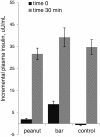The effect of peanut and grain bar preloads on postmeal satiety, glycemia, and weight loss in healthy individuals: an acute and a chronic randomized intervention trial
- PMID: 23537225
- PMCID: PMC3620575
- DOI: 10.1186/1475-2891-12-35
The effect of peanut and grain bar preloads on postmeal satiety, glycemia, and weight loss in healthy individuals: an acute and a chronic randomized intervention trial
Abstract
Background: Peanut consumption favorably influences satiety. This study examined the acute effect of peanut versus grain bar preloads on postmeal satiety and glycemia in healthy adults and the long-term effect of these meal preloads on body mass in healthy overweight adults.
Methods: In the acute crossover trial (n = 15; 28.4 ± 2.9 y; 23.1 ± 0.9 kg/m2), the preload (isoenergetic peanut or grain bar with water, or water alone) was followed after 60 min with ingestion of a standardized glycemic test meal. Satiety and blood glucose were assessed immediately prior to the preload and to the test meal, and for two hours postmeal at 30-min intervals. In the parallel-arm, randomized trial (n = 44; 40.5 ± 1.6 y, 31.8 ± 0.9 kg/m2), the peanut or grain bar preload was consumed one hour prior to the evening meal for eight weeks. Body mass was measured at 2-week intervals, and secondary endpoints included blood hemoglobin A1c and energy intake as assessed by 3-d diet records collected at pre-trial and trial weeks 1 and 8.
Results: Satiety was elevated in the postprandial period following grain bar ingestion in comparison to peanut or water ingestion (p = 0.001, repeated-measures ANOVA). Blood glucose was elevated one hour after ingestion of the grain bar as compared to the peanut or water treatments; yet, total glycemia did not vary between treatments in the two hour postprandial period. In the 8-week trial, body mass was reduced for the grain bar versus peanut groups after eight weeks (-1.3 ± 0.4 kg versus -0.2 ± 0.3 kg, p = 0.033, analysis of covariance). Energy intake was reduced by 458 kcal/d in the first week of the trial for the grain bar group as compared to the peanut group (p = 0.118). Hemoglobin A1c changed significantly between groups during the trial (-0.25 ± 0.07% and -0.18 ± 0.12% for the grain bar and peanut groups respectively, p = 0.001).
Conclusions: Compared to an isoenergetic peanut preload, consumption of a grain bar preload one hour prior to a standardized meal significantly raised postmeal satiety. Moreover, consumption of the grain bar prior to the evening meal was associated with significant weight loss over time suggesting that glycemic carbohydrate ingestion prior to meals may be a weight management strategy.
Figures




References
-
- Center for Disease Control. Behavioral risk factor surveillance system. http://apps.nccd.cdc.gov/brfss/list.asp?cat=OB&yr=2010&qkey=4409&state=All.
-
- Center for Disease Control. FastStats. http://www.cdc.gov/nchs/fastats/overwt.htm.
-
- Sabaté J. Nut consumption and body weight. Am J Clin Nutr. 2003;78(3 Suppl):647S–650S. - PubMed
-
- Mattes RD. The energetics of nut consumption. Asia Pac J Clin Nutr. 2008;17(Suppl 1):337–339. - PubMed
Publication types
MeSH terms
Substances
LinkOut - more resources
Full Text Sources
Other Literature Sources
Medical

